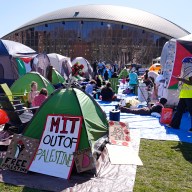Demilitarized Zone draws busloads of curious visitors
julia dimon/for metro toronto
A statue that symbolizes the hope that north and south will unify.
While in Seoul, many tourists, especially those with an interest in the Korean War, opt for a tour of the DMZ.
Created in the 1950s, the Demilitarized Zone is a 4km wide no-go area that separates the country into north and south.
Anxious for a taste of world history and a glimpse of North Korea, I reserved a tour. Early morning, the tour bus picked me up at my hotel.
We drove an hour north of Seoul toward Korea’s famous demarcation line. When the scenic landscape turned into electrical fences and armed guards posted in watchtowers, I knew we had arrived.
A tour guide takes tourists on a tour of the Demilitarized Zone.
A young soldier in a camouflage uniform surveyed our bus. He scanned the Western and Japanese tourists and motioned for us to proceed. As we drove towards the Third Infiltration Tunnel, yellow triangular signs bearing the words “land mine” dotted the way.
Though I never felt nervous about my own safety, those two cautionary words did remind me that the DMZ was serious business. Only organized tour groups are permitted to enter the restricted area, and visitors must book such tours in advance, bring their passports and, according to brochures, dress “appropriately” — no sandals, no jeans, no shorts, no tank tops or mini skirts.
First stop on the tour was the Third Infiltration Tunnel. I slipped on a hard hat and, together with my tour group, descended underground.
Hunched over, occasionally hitting my plastic helmet on the low rock ceiling, I followed the well-lit path, along moist granite walls.
This secret passage, built by North Korean soldiers, went underneath the DMZ into South Korean territory.
In 1978 it was discovered and the threat neutralized. Today, many parts of the tunnel are sealed shut, while others remain open for tourists.
Tourists can buy a piece of barbed wire from the DMZ.
After a little tunnel exploration our group filed back to the bus and drove towards the Dora Observation Platform.
It was here that I finally caught a glimpse of North Korea.
The scene was an empty panorama: a winding river, a few industrial buildings in the distance, a giant flag flapping over an abandoned village.
There I was, standing safely on the South Korean side of the DMZ, overlooking the Democratic People’s Republic of Korea.
Despite being so close, this communist country, made infamous by its quirky dictator, remained a mystery. For more information on DMZ tours, visit www.tour2korea.com.
Julia Dimon, a Toronto-based freelance writer, is travelling around the world. She can be reached through www.thetraveljunkie.ca.















